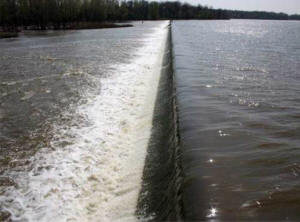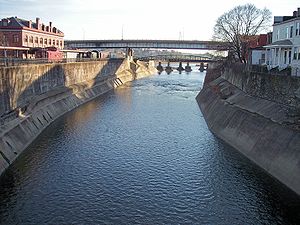Introduction
Most of the hazards to be discussed in this article are manmade. As a general rule, I highly recommend portaging around man made obstructions. Most of these are made with concrete (not so bad) and reinforcement bar (very bad). They tend to break down over time exposing dangerous steel spikes. Although the plastic in our modern boats is quite strong, it is no match for a sharp steel rod which can puncture any boat instantaneously. Another problem with dams and pipelines is their perfectly uniform and smooth construction. This leads to holes with a very large backwash and no good way to escape.
Dams
 Dams can be manmade or natural. Of particular concern are low head dams also known as "The Drowning Machine). Manmade structures may also contain exposed rebar which can easily puncture plastic boats. Take great care whenever running manmade structures. This feature is so important to recognize I suggest you watch the following video: Low Head Dams. We will show you an example of a low head dam at Brookmont on the second day of our class.
Dams can be manmade or natural. Of particular concern are low head dams also known as "The Drowning Machine). Manmade structures may also contain exposed rebar which can easily puncture plastic boats. Take great care whenever running manmade structures. This feature is so important to recognize I suggest you watch the following video: Low Head Dams. We will show you an example of a low head dam at Brookmont on the second day of our class.
Flow Diversion Structures
 Many towns construct sluiceways to channelize water so it doesn't flood nearby neighborhoods. Notice the picture on the right, looks pretty harmless. Now imagine what it would look like with a lot more water. If you flip and swim, how in the world can you recover? The smooth sidewalls tend to make the water flow very fast as well so even if you did find something to hang on to, you will tire very quickly. Eventually the concrete structure comes to an end. The end is typically perfectly uniform and a real death trap of a hole. As tempting as this feature looks, stay away from these hazards and stick with the natural streams. One other this to consider, in many towns there are laws against entering these flood control sluices. Many people have drowned in them and rescues are very dangerous for the local fire departments.
Many towns construct sluiceways to channelize water so it doesn't flood nearby neighborhoods. Notice the picture on the right, looks pretty harmless. Now imagine what it would look like with a lot more water. If you flip and swim, how in the world can you recover? The smooth sidewalls tend to make the water flow very fast as well so even if you did find something to hang on to, you will tire very quickly. Eventually the concrete structure comes to an end. The end is typically perfectly uniform and a real death trap of a hole. As tempting as this feature looks, stay away from these hazards and stick with the natural streams. One other this to consider, in many towns there are laws against entering these flood control sluices. Many people have drowned in them and rescues are very dangerous for the local fire departments.
Pipelines
 Pipelines can act very similar to a manmade dam. They are essentially uniform with no breaks and at the right water level, they form holes that are very difficult to escape from. These need to be carefully scouted prior to running. Another worry about running a pipeline is the danger of undercuts. Since they are round, water can work its way underneath and create a dangerous entrapment possibility. Pipelines also need to be secured along their route which may leave areas where a boat or person can be snagged. Look before you leap.
Pipelines can act very similar to a manmade dam. They are essentially uniform with no breaks and at the right water level, they form holes that are very difficult to escape from. These need to be carefully scouted prior to running. Another worry about running a pipeline is the danger of undercuts. Since they are round, water can work its way underneath and create a dangerous entrapment possibility. Pipelines also need to be secured along their route which may leave areas where a boat or person can be snagged. Look before you leap.
